Sales Mode Selection Strategic Analysis for Manufacturers on E-Commerce Platforms under Multi-Channel Competition
Abstract
1. Introduction
- (1)
- Under what conditions do manufacturers choose resale mode or agency mode?
- (2)
- What influence do manufacturers’ sales mode selection strategies have on each member and the whole supply chain? Is it beneficial or harmful? Can we achieve a win–win supply chain?
2. Literature Review
2.1. Supply Chain Management of Channels
2.2. Sales Mode Selection on E-Commerce Platforms
3. Problem Formulation
4. The Models
4.1. The Resale Mode
4.2. The Agency Mode
5. Numerical Analysis
5.1. Manufacturer’s Sales Mode Selection Analysis
5.1.1. Low Commission Rate ()
5.1.2. Moderate Commission Rate ()
5.1.3. High Commission Rate ()
5.2. Impact of Each Parameter on Each Member
6. Discussion and Conclusions
- (1)
- The manufacturer’s sales mode selection strategy is mainly affected by price competition intensity, market share of channel, and commission rate. To be specific, when the market share of the traditional retail channel is lower than the direct selling channel, the manufacturer should choose agency mode if the market share of the direct selling channel is low and the price competition intensity is weak, or if both the market share of the direct selling channel and the commission rate are high, and the price competition intensity is strong; otherwise, the manufacturer should choose resale mode. When the market share of the direct selling channel is lower than the traditional retail channel, the manufacturer should choose agency mode if the price competition intensity is weak and choose resale mode if the price competition intensity is strong. In particular, the manufacturer is more inclined to choose the resale mode with an increased commission rate. This finding is consistent with the actual situation (e.g., merchants on the platform always want to pay as little commission rate as possible, because in this way they can obtain more profits). In addition, we find that the market share of each channel has a great impact on the sales mode selection strategy. Different from other studies that assume that the market share of the traditional retail channels is higher or lower than that of the direct selling channels, this paper presents the sales mode selection strategy under different market share distribution ratios, which is our characteristic. This finding can solve more problems and has a certain practical significance. In addition, it also provides a new idea for follow-up research on multi-channel supply chains.
- (2)
- By comparing the optimal prices in the same channel under two sales modes, we found that the change of channel price is only related to the market share of the channel but has nothing to do with the price competition intensity and the commission rate. Compared with agency mode, if the market share of the direct selling channel is lower than e-commerce platform channel, the optimal prices of the traditional retail channel and e-commerce platform channel are high in resale mode, while the optimal price of the direct selling channel is low. This is mainly because the price of the traditional retail channels and e-commerce platform channels decreases with the market share of the direct selling channels in the resale mode but increases with it in the agency mode. In other words, manufacturers expanding direct selling channels under the resale mode are detrimental to traditional retailers and e-commerce platforms. This goes a long way towards explaining why some distributors are reluctant to let their suppliers expand their online channels because it would hurt their profits.
- (3)
- When both the price competition intensity and the commission rate are moderate, the manufacturer chooses agency mode if the market share of the direct selling channel is lower than the traditional retail channel and chooses resale mode if the market share of the direct selling channel is higher than the traditional retail channel, which can achieve a win–win situation for all members and promote the coordination of the supply chain. Interestingly, references [1,14,33] show that manufacturers achieve supply chain win–wins only under the agency mode. This finding suggests that no matter what sales mode manufacturers choose, there is a possibility that traditional retailers and e-commerce platforms are willing to compete and cooperate with them, which well explains why such sales structures are prevalent in real life and makes our study meaningful.
Author Contributions
Funding
Data Availability Statement
Conflicts of Interest
Appendix A
References
- Hagiu, A.; Wright, J. Marketplace or reseller? Manage. Sci. 2015, 61, 184–203. [Google Scholar] [CrossRef]
- Wei, J.; Wang, Y.; Lu, J. Information sharing and sales patterns choice in a supply chain with product’s greening improvement. J. Clean. Prod. 2021, 278, 123704. [Google Scholar] [CrossRef]
- Chiang, W.Y.K.; Chhajed, D.; Hess, J.D. Direct marketing, indirect profits: A strategic analysis of dual-channel supply-chain design. Manage. Sci. 2003, 49, 1–20. [Google Scholar] [CrossRef]
- Matsui, K. When should a manufacturer set its direct price and wholesale price in dual-channel supply chains? Eur. J. Oper. Res. 2017, 258, 501–511. [Google Scholar] [CrossRef]
- Yi, Z.; Wang, Y.; Liu, Y.; Chen, Y.J. The impact of consumer fairness seeking on distribution channel selection: Direct selling vs. agent selling. Prod. Oper. Manag. 2018, 27, 1148–1167. [Google Scholar] [CrossRef]
- Wang, C.; Leng, M.; Liang, L. Choosing an online retail channel for a manufacturer: Direct sales or consignment? Int. J. Prod. Econ. 2018, 195, 338–358. [Google Scholar] [CrossRef]
- Pu, X.; Sun, S.; Shao, J. Direct selling, reselling, or agency selling? Manufacturer’s online distribution strategies and their impact. Int. J. Electron. Commer. 2020, 24, 232–254. [Google Scholar] [CrossRef]
- Wang, T.Y.; Wang, X.J.; He, P.; Chen, Z.S. Retailer’s selling mode choice under different competition forms. Int. Trans. Oper. Res. 2022, 29, 3712–3736. [Google Scholar] [CrossRef]
- Ma, J.; Lou, W.; Tian, Y. Bullwhip effect and complexity analysis in a multi-channel supply chain considering price game with discount sensitivity. Int. J. Prod. Res. 2019, 57, 5432–5452. [Google Scholar] [CrossRef]
- Ryan, J.K.; Sun, D.; Zhao, X. Competition and coordination in online marketplaces. Prod. Oper. Manag. 2012, 21, 997–1014. [Google Scholar] [CrossRef]
- Mantin, B.; Krishnan, H.; Dhar, T. The strategic role of third-party marketplaces in retailing. Prod. Oper. Manag. 2014, 23, 1937–1949. [Google Scholar] [CrossRef]
- Yan, Y.; Zhao, R.; Xing, T. Strategic introduction of the marketplace channel under dual upstream disadvantages in sales efficiency and demand information. Eur. J. Oper. Res. 2019, 273, 968–982. [Google Scholar] [CrossRef]
- Ha, A.Y.; Luo, H.; Shang, W. Supplier encroachment, information sharing, and channel structure in online retail platforms. Prod. Oper. Manag. 2022, 31, 1235–1251. [Google Scholar] [CrossRef]
- Abhishek, V.; Jerath, K.; Zhang, Z.J. Agency selling or reselling? Channel structures in electronic retailing. Manage. Sci. 2016, 62, 2259–2280. [Google Scholar] [CrossRef]
- Zhu, C.; Yao, Z. Comparison between the agency and wholesale model under the e-book duopoly market. Electron. Commer. Res. 2018, 18, 313–337. [Google Scholar] [CrossRef]
- Li, Z.; Ho, Y.C.; Nan, G.; Li, M. Agency or resale: Effects of a platform-performance investment for frenemy platforms. Decis. Support Syst. 2019, 124, 113098. [Google Scholar] [CrossRef]
- Liu, B.; Guo, X.; Yu, Y.; Tian, L. Manufacturer’s contract choice facing competing downstream online retail platforms. Int. J. Prod. Res. 2021, 59, 3017–3041. [Google Scholar] [CrossRef]
- Wei, J.; Lu, J.; Wang, Y. How to choose online sales formats for competitive e-tailers. Int. Trans. Oper. Res. 2021, 28, 2055–2080. [Google Scholar] [CrossRef]
- Kwark, Y.; Chen, J.; Raghunathan, S. Platform or wholesale? A strategic tool for online retailers to benefit from third-party information. MIS Q. 2017, 41, 763–786. [Google Scholar] [CrossRef]
- Chen, L.; Nan, G.; Li, M. Wholesale pricing or agency pricing on online retail platforms: The effects of customer loyalty. Int. J. Electron. Commer. 2018, 22, 576–608. [Google Scholar] [CrossRef]
- Tian, L.; Vakharia, A.J.; Tan, Y.; Xu, Y. Marketplace, reseller, or hybrid: Strategic analysis of an emerging e-commerce model. Prod. Oper. Manag. 2018, 27, 1595–1610. [Google Scholar] [CrossRef]
- Wei, J.; Lu, J.; Zhao, J. Interactions of competing manufacturers’ leader-follower relationship and sales format on online platforms. Eur. J. Oper. Res. 2020, 280, 508–522. [Google Scholar] [CrossRef]
- Zennyo, Y. Strategic contracting and hybrid use of agency and wholesale contracts in e-commerce platforms. Eur. J. Oper. Res. 2020, 281, 231–239. [Google Scholar] [CrossRef]
- Zhong, B.; Shen, H.; Zhang, J.; Gao, X. Agency or wholesale? Retail selling format in the presence of new manufacturer introduction. Electron. Commer. Res. 2022, 1–35. [Google Scholar] [CrossRef]
- Li, X.; Ai, X. A choice of selling format in the online marketplace with cross-sales supply chain: Platform selling or traditional reselling? Electron. Commer. Res. 2021, 21, 393–422. [Google Scholar] [CrossRef]
- Jerath, K.; Zhang, Z. Store within a store. J. Mark. Res. 2010, 47, 748–763. [Google Scholar] [CrossRef]
- Jiang, B.; Jerath, K.; Srinivasan, K. Firm strategies in the “mid tail” of platform-based retailing. Mark. Sci. 2011, 30, 757–775. [Google Scholar] [CrossRef]
- Hao, L.; Tan, Y. Who wants consumers to be informed? Facilitating information disclosure in a distribution channel. Inf. Syst. Res. 2019, 30, 34–49. [Google Scholar] [CrossRef]
- Belhadj, N.; Laussel, D.; Resende, J. Marketplace or reselling? A signaling model. Inf. Econ. Policy 2020, 50, 100834. [Google Scholar] [CrossRef]
- Liu, W.; Yan, X.; Li, X.; Wei, W. The impacts of market size and data-driven marketing on the sales mode selection in an internet platform-based supply chain. Transp. Res. Pt. E-Logist. Transp. Rev. 2020, 136, 101914. [Google Scholar] [CrossRef]
- Shi, S.; Sun, J.; Cheng, T.C.E. Wholesale or drop-shipping: Contract choices of the online retailer and the manufacturer in a dual-channel supply chain. Int. J. Prod. Econ. 2020, 226, 107618. [Google Scholar] [CrossRef]
- Qin, X.; Liu, Z.; Tian, L. The optimal combination between selling mode and logistics service strategy in an e-commerce market. Eur. J. Oper. Res. 2021, 289, 639–651. [Google Scholar] [CrossRef]
- Chen, L.; Nan, G.; Li, M.; Feng, B.; Liu, Q. Manufacturer’s online selling strategies under spillovers from online to offline sales. J. Oper. Res. Soc. 2022. [Google Scholar] [CrossRef]
- Ha, A.Y.; Tong, S.; Wang, Y. Channel structures of online retail platforms. Manuf. Serv. Oper. Manag. 2022, 24, 1547–1561. [Google Scholar] [CrossRef]
- Tan, Y.; Carrillo, J.E. Strategic analysis of the agency model for digital goods. Prod. Oper. Manag. 2017, 26, 724–741. [Google Scholar] [CrossRef]
- Dennis, Z.Y.; Cheong, T.; Sun, D. Impact of supply chain power and drop-shipping on a manufacturer’s optimal distribution channel strategy. Eur. J. Oper. Res. 2017, 259, 554–563. [Google Scholar]
- Geng, X.; Tan, Y.; Wei, L. How add-on pricing interacts with distribution contracts. Prod. Oper. Manag. 2018, 27, 605–623. [Google Scholar] [CrossRef]
- Shen, Y.; Yang, X.; Dai, Y. Manufacturer-retail platform interactions in the presence of a weak retailer. Int. J. Prod. Res. 2019, 57, 2732–2754. [Google Scholar] [CrossRef]
- Zhang, S.; Zhang, J. Agency selling or reselling: E-tailer information sharing with supplier offline entry. Eur. J. Oper. Res. 2020, 280, 134–151. [Google Scholar] [CrossRef]
- Chen, P.; Zhao, R.; Yan, Y.; Li, X. Promotional pricing and online business model choice in the presence of retail competition. Omega 2020, 94, 102085. [Google Scholar] [CrossRef]
- Lu, Q.; Shi, V.; Huang, J. Who benefit from agency model: A strategic analysis of pricing models in distribution channels of physical books and e-books. Eur. J. Oper. Res. 2018, 264, 1074–1091. [Google Scholar] [CrossRef]
- Alaei, A.M.; Taleizadeh, A.A.; Rabbani, M. Marketplace, reseller, or web-store channel: The impact of return policy and cross-channel spillover from marketplace to web-store. J. Retail. Consum. Serv. 2020, 65, 102271. [Google Scholar] [CrossRef]
- Guo, F.; Ma, D.; Hu, J.; Zhang, L. Optimized combination of e-commerce platform sales model and blockchain anti-counterfeit traceability service strategy. IEEE Access 2021, 9, 138082–138105. [Google Scholar] [CrossRef]
- Hao, C.; Yang, L. Resale or agency sale? Equilibrium analysis on the role of live streaming selling. Eur. J. Oper. Res. 2022; in press. [Google Scholar] [CrossRef]
- Wang, Q.; Zhao, N.; Ji, X. Reselling or agency selling? The strategic role of live streaming commerce in distribution contract selection. Electron. Commer. Res. 2022. [Google Scholar] [CrossRef]
- Hu, H.; Zheng, Q.; Pan, X.A. Agency or Wholesale? The Role of Retail Pass-Through. Manage. Sci. 2022, 68, 7065–7791. [Google Scholar] [CrossRef]
- Shi, G.; Jiang, L.; Wang, Y. Interaction between the introduction strategy of the third-party online channel and the choice of online sales format. Int. Trans. Oper. Res. 2022, 29, 2448–2493. [Google Scholar] [CrossRef]
- Zhang, Y.; Li, B.; Zhao, R. Resale or agency: Pricing strategy for advance selling in a supply chain considering consumers’ loss aversion. IMA J. Manag. Math. 2022, 33, 229–254. [Google Scholar] [CrossRef]
- Chen, L.; Nan, G.; Liu, Q.; Peng, J.; Ming, J. How Do Consumer Fairness Concerns Affect an E-Commerce Platform’s Choice of Selling Scheme? J. Theor. Appl. Electron. Commer. Res. 2022, 17, 1075–1106. [Google Scholar] [CrossRef]
- Kurata, H.; Yao, D.Q.; Liu, J.J. Pricing policies under direct vs. indirect channel competition and national vs. store brand competition. Eur. J. Oper. Res. 2007, 180, 262–281. [Google Scholar] [CrossRef]
- Dan, B.; Xu, G.; Liu, C. Pricing policies in a dual-channel supply chain with retail services. Int. J. Prod. Econ. 2012, 139, 312–320. [Google Scholar] [CrossRef]
- Wang, R.; Nan, G.; Chen, L.; Li, M. Channel integration choices and pricing strategies for competing dual-channel retailers. IEEE Trans. Eng. Manag. 2022, 69, 2260–2274. [Google Scholar] [CrossRef]
- Valeri, M. Organizational Studies; Springer International Publishing: Cham, Switzerland, 2021; ISBN 978-3-030-87147-5. [Google Scholar]
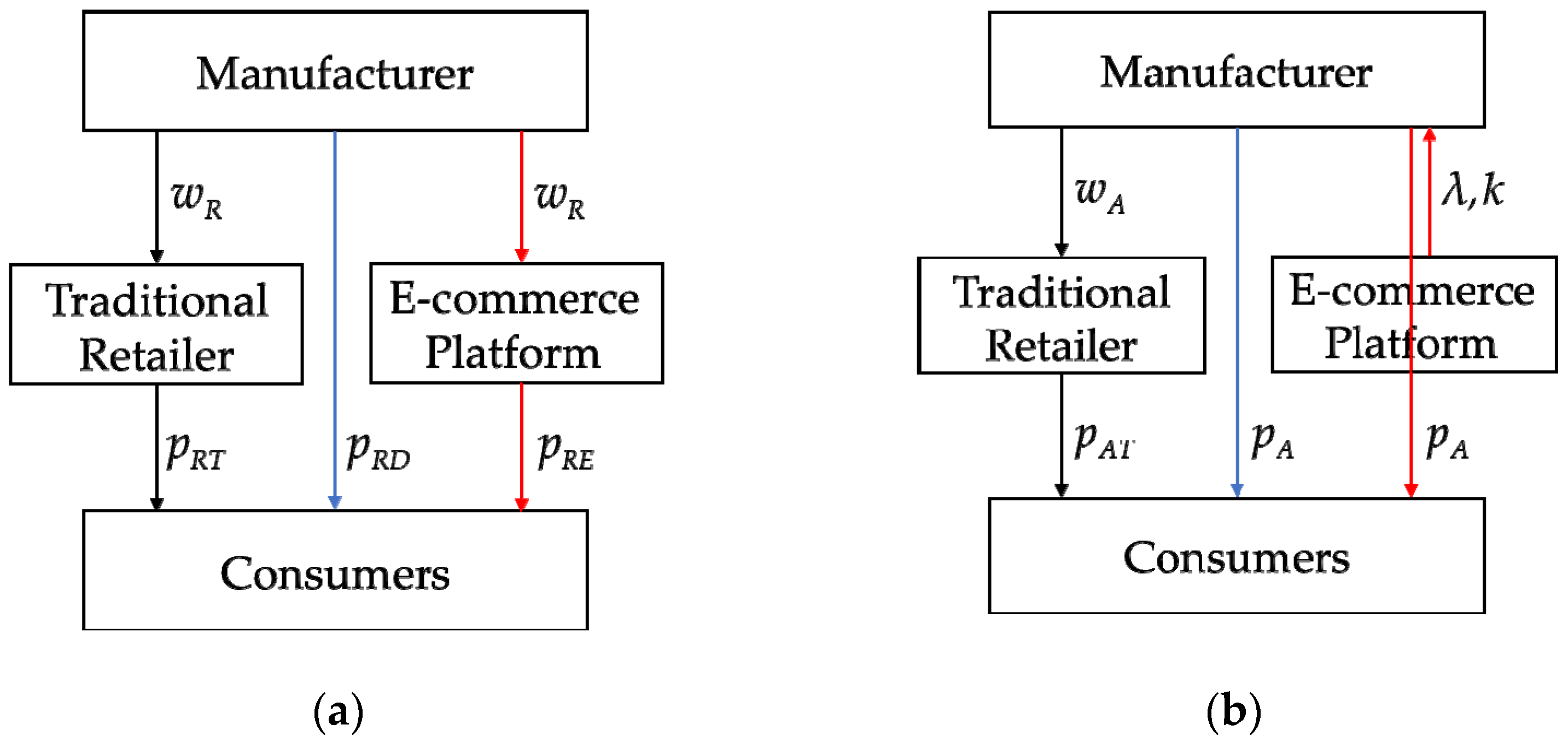
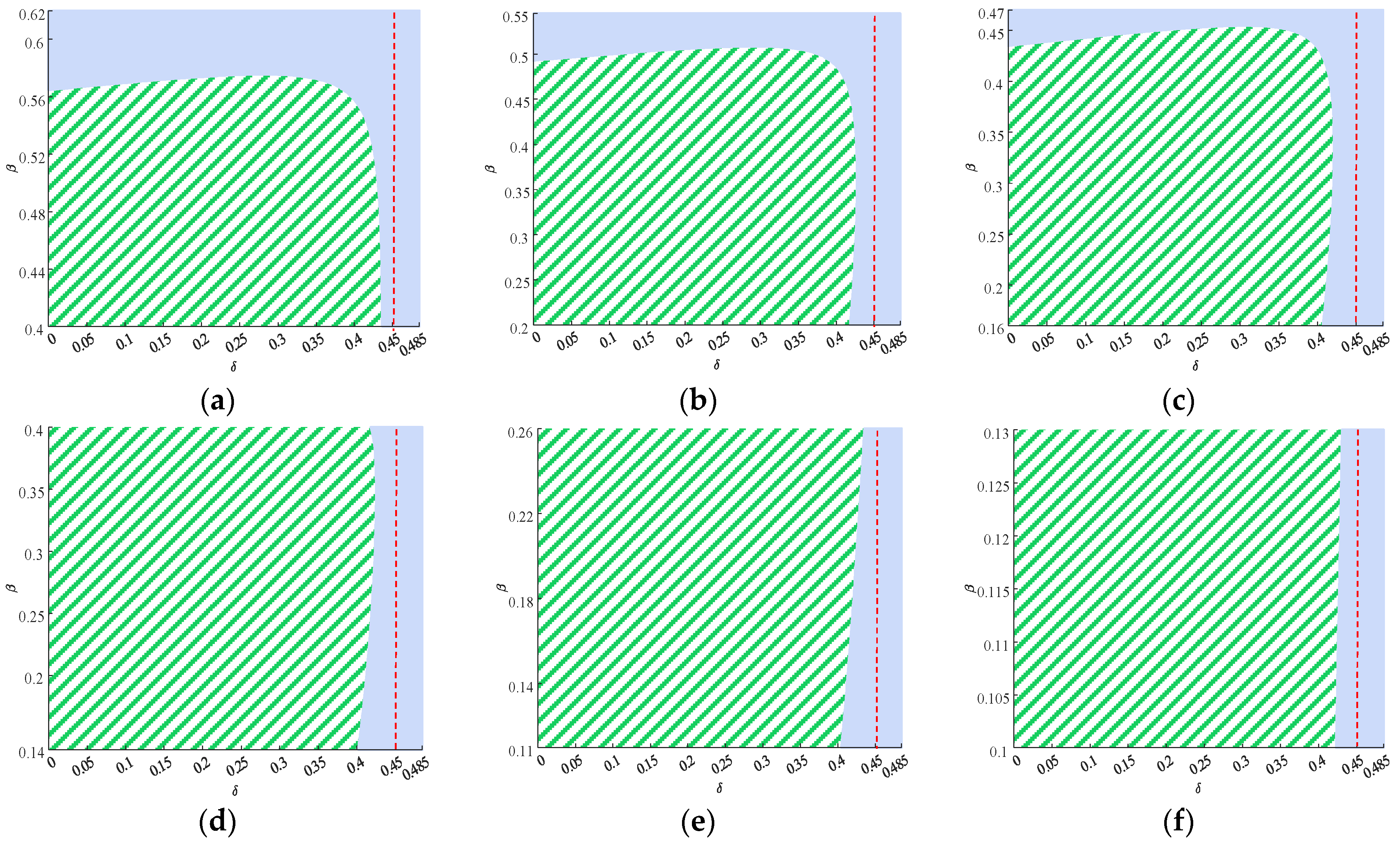

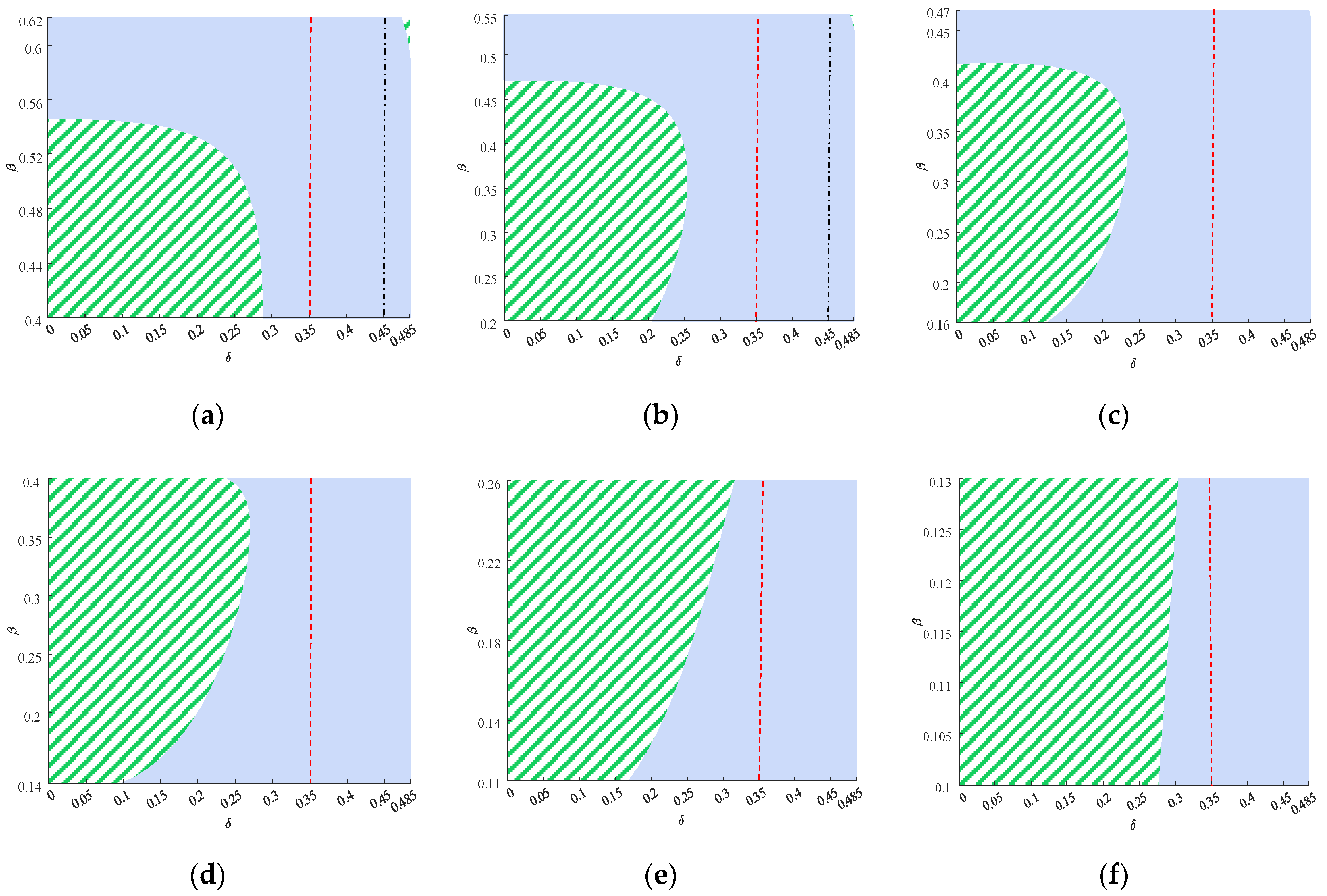

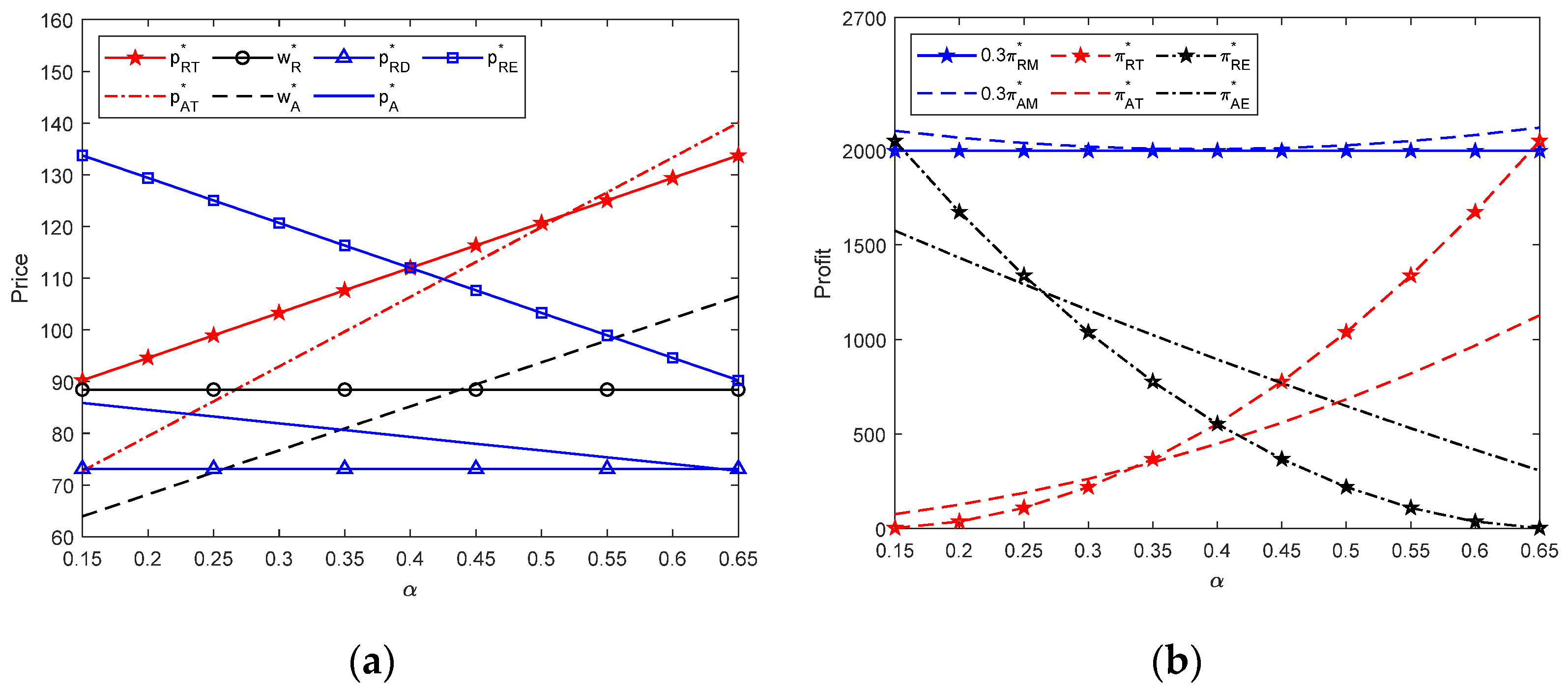
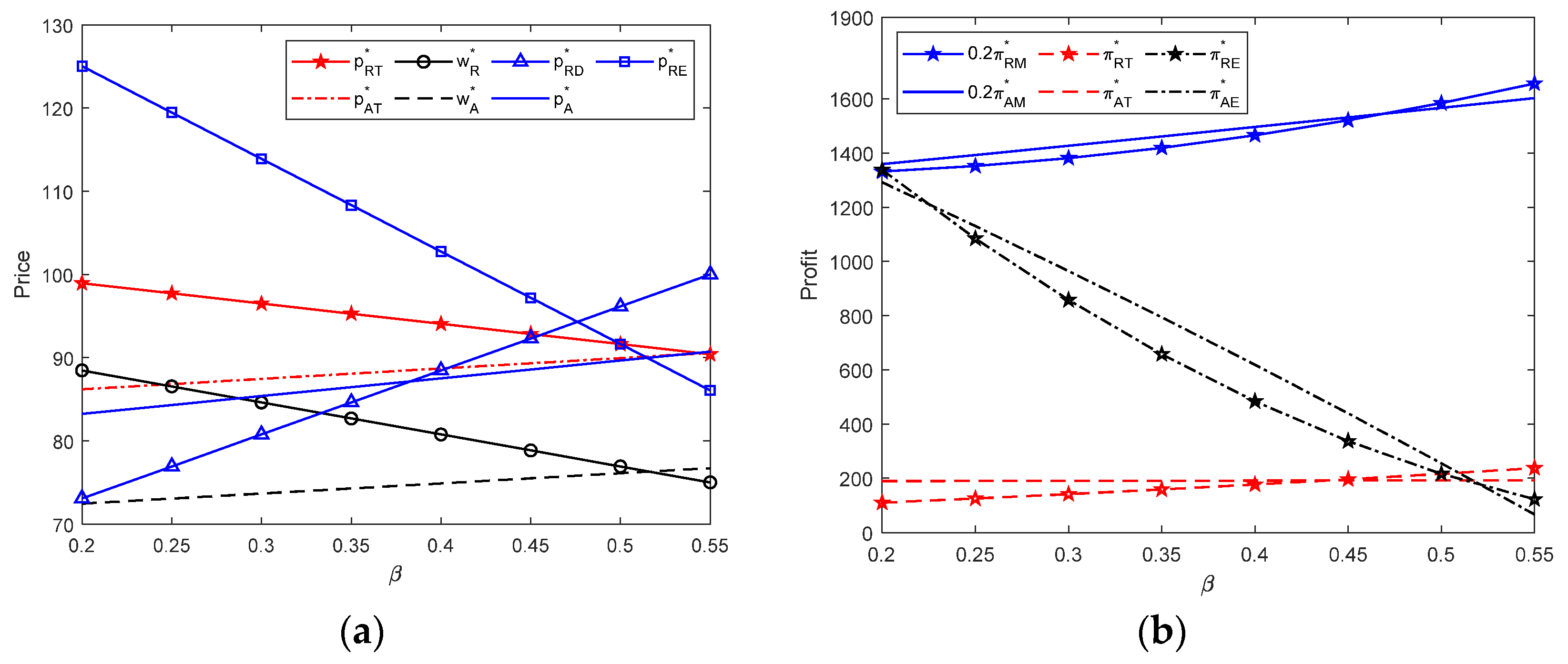
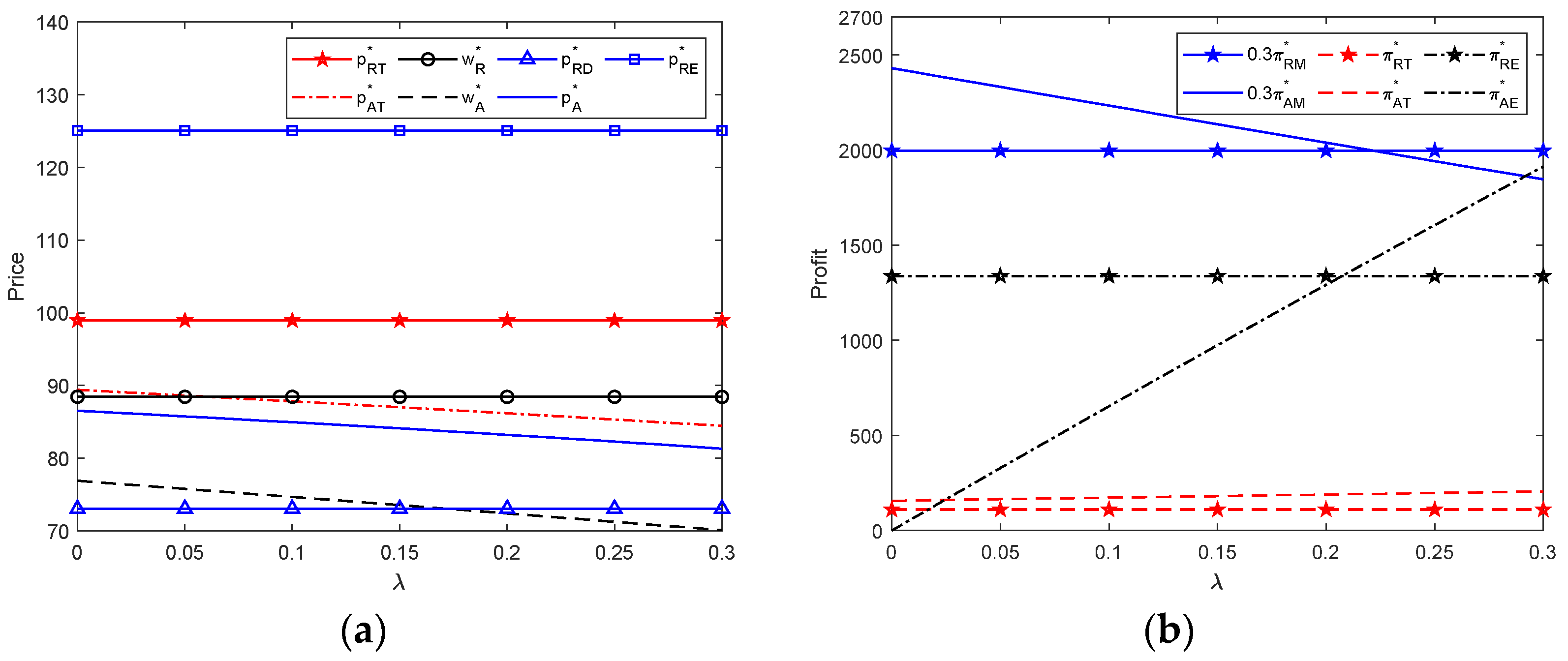
| Reference | Channel Structure | Research Focus | Type of Channel | ||||
|---|---|---|---|---|---|---|---|
| Traditional Retail | Direct Selling | Reselling | Resale | Agency | |||
| [3,4] | Dual | Impact of manufacturer intrusion | √ | √ | |||
| [5,6] | Dual | Selection of online channels | √ | √ | √ | ||
| [7] | Dual | Selection of online channels | √ | √ | √ | √ | |
| [8] | Dual | Selection of online channels | √ | √ | √ | ||
| [9] | Multi | Bullwhip effect in a multi-channel supply chain | √ | √ | √ | ||
| Our study | Multi | Sales mode selection of e-commerce platform | √ | √ | √ | √ | |
| Reference | Channel Structure | Research Focus (Problem) | Leader | Type of Channel | |||
|---|---|---|---|---|---|---|---|
| T | D | R | A | ||||
| [14] | Dual | When should an e-tailer use agency selling | Manufacturer | √ | √ | ||
| [18] | Dual | How to choose online sales formats for competitive e-tailers | Manufacturer | √ | √ | ||
| [20] | Dual | Online retailer’s pricing model choice | Manufacturers | √ | √ | ||
| [22] | Dual | How do manufacturers choose the best sales formats | E-tailer | √ | √ | ||
| [33] | Dual | Manufacturer’s online sales mode selection | Manufacturer | √ | √ | √ | |
| [36] | Dual | Manufacturer’s online sales mode selection | Manufacturer | √ | √ | √ | |
| [37] | Single | Manufacturer’s additional pricing and distribution strategy | Platform | √ | √ | ||
| [38] | Dual | The interaction between sales mode and channel choice | Dominant retailer | √ | √ | √ | |
| [39] | Dual | Strategic interaction between e-tailer’s information sharing and supplier’s offline entry | E-tailer | √ | √ | √ | |
| Our study | Multi | Manufacturer’s selection of sales mode under multi-channel | Manufacturer | √ | √ | √ | √ |
| Notation | Description |
|---|---|
| Set | |
| Set of sales modes : represents resale mode; represents agency mode | |
| Set of channels : represents traditional retail channel; represents direct selling channel; represents e-commerce platform channel | |
| Parameter | |
| Market share of traditional retail channel, | |
| Market share of direct selling channel, | |
| Intensity of price competition, | |
| Potential market demand | |
| Commission rate in agency mode, | |
| Slotting fee in agency mode | |
| Decision variable | |
| Wholesale price in sales mode | |
| Retail price of traditional retail channel in sales mode | |
| Retail price of direct selling channel in resale mode | |
| Retail price of e-commerce platform channel in resale mode | |
| Price vector in resale mode | |
| Retail price of direct selling channel and e-commerce platform channel in agency mode | |
| Dependent variable | |
| Demand function of channel in sales mode | |
| Profit of manufacturer, retailer and e-commerce platform in sales mode |
| Variables | |||||||||||||
|---|---|---|---|---|---|---|---|---|---|---|---|---|---|
| - | - | - | |||||||||||
| - | - | - | - | - | - | - |
Publisher’s Note: MDPI stays neutral with regard to jurisdictional claims in published maps and institutional affiliations. |
© 2022 by the authors. Licensee MDPI, Basel, Switzerland. This article is an open access article distributed under the terms and conditions of the Creative Commons Attribution (CC BY) license (https://creativecommons.org/licenses/by/4.0/).
Share and Cite
Lin, G.; Xiong, X.; Li, Y.; Zhu, X. Sales Mode Selection Strategic Analysis for Manufacturers on E-Commerce Platforms under Multi-Channel Competition. Systems 2022, 10, 234. https://doi.org/10.3390/systems10060234
Lin G, Xiong X, Li Y, Zhu X. Sales Mode Selection Strategic Analysis for Manufacturers on E-Commerce Platforms under Multi-Channel Competition. Systems. 2022; 10(6):234. https://doi.org/10.3390/systems10060234
Chicago/Turabian StyleLin, Guihua, Xiaoli Xiong, Yuwei Li, and Xide Zhu. 2022. "Sales Mode Selection Strategic Analysis for Manufacturers on E-Commerce Platforms under Multi-Channel Competition" Systems 10, no. 6: 234. https://doi.org/10.3390/systems10060234
APA StyleLin, G., Xiong, X., Li, Y., & Zhu, X. (2022). Sales Mode Selection Strategic Analysis for Manufacturers on E-Commerce Platforms under Multi-Channel Competition. Systems, 10(6), 234. https://doi.org/10.3390/systems10060234






